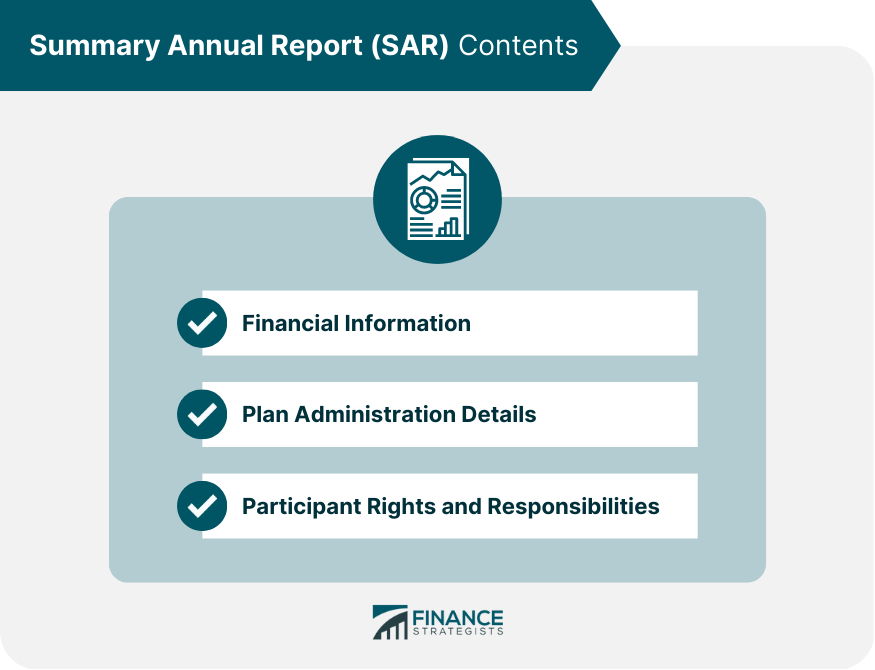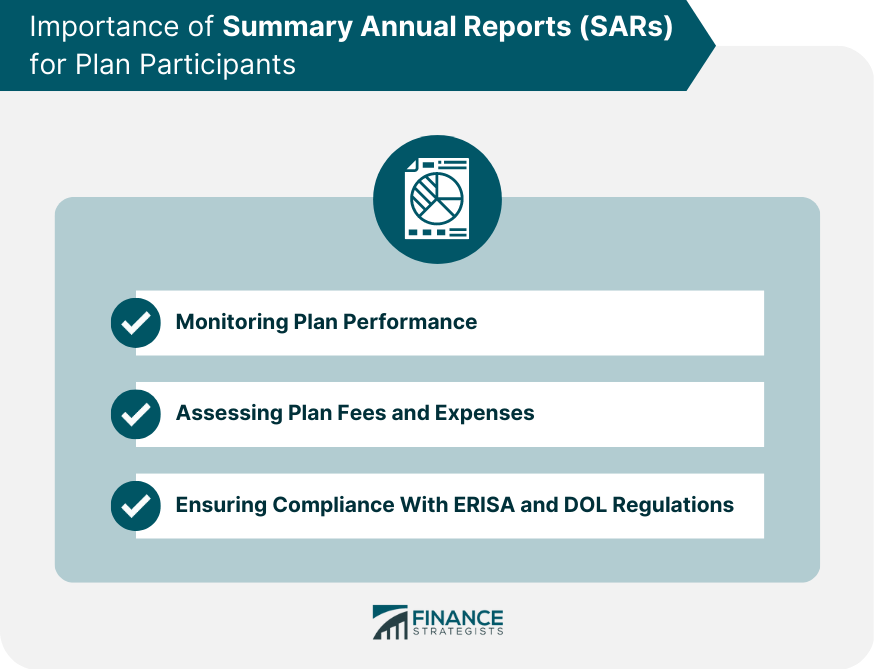A Summary Annual Report is a document that provides plan participants with a condensed version of the financial and administrative information contained in a retirement or welfare benefit plan's annual filing with the Department of Labor (DOL). The primary purpose of the SAR is to provide transparency and ensure compliance with the Employee Retirement Income Security Act (ERISA) by offering plan participants an overview of the plan's financial status, investments, and administration. ERISA and the DOL establish specific regulatory requirements for the preparation, distribution, and filing of SARs for qualified benefit plans. The SAR includes essential financial information, such as the plan's assets, liabilities, income, and expenses. It also provides an overview of the plan's investment performance and returns. The SAR contains information about the plan's administration, including the names and contact details of the plan sponsor and administrator, as well as any changes made to the plan during the year. The SAR informs plan participants of their rights and responsibilities, such as the right to request plan documents and the responsibility to update personal information. The following types of plans typically require an SAR: Health and welfare plans ERISA sets forth various requirements for SARs, including filing deadlines, distribution methods, and recordkeeping requirements. Plan administrators must distribute the SAR to plan participants within nine months after the end of the plan year or two months after the annual report (Form 5500) filing deadline, whichever is later. Plan administrators can distribute the SAR using various methods, such as mail, email, or posting on a secure website, as long as they comply with DOL guidelines for electronic delivery. Plan administrators must retain records related to the SAR for at least six years after the filing date. DOL regulations govern specific aspects of SAR preparation and distribution, including electronic delivery guidelines, model SAR language, and penalties for noncompliance. Plan administrators must follow DOL guidelines for electronic delivery of the SAR, such as obtaining participant consent and providing notice of electronic availability. The DOL provides model language for preparing an SAR to help plan administrators meet regulatory requirements and ensure clear communication with plan participants. Failure to comply with ERISA and DOL regulations regarding SARs can result in significant penalties, including fines and legal action. Understanding the plan's financial information in the SAR can help participants assess the plan's overall health and investment performance. The SAR provides a snapshot of the plan's assets and liabilities, which can help participants gauge the plan's financial stability. The SAR includes a summary of the plan's income and expenses, offering insight into the plan's financial operations and efficiency. The SAR provides an overview of the plan's investment performance, allowing participants to evaluate the plan's returns relative to their investment objectives. The SAR identifies the plan sponsor and administrator, which is essential information for participants who need to contact these parties for assistance or information. The SAR may include information about service providers, such as investment managers and recordkeepers, who play a crucial role in managing the plan and ensuring its proper administration. The SAR highlights any changes made to the plan during the year, which can impact participants' benefits and investment options. The SAR informs participants of their right to request plan documents, such as the full annual report, plan description, and trust agreement, which can provide more in-depth information about the plan's administration and investments. Participants who believe their plan is not being administered in compliance with ERISA or DOL regulations have the right to file a complaint with the DOL. The SAR reminds participants of their responsibility to update personal information, such as their address or beneficiary designation, to ensure they receive important plan communications and benefits. The report provides an overview of the plan's investment performance, including the rate of return and fees charged by investment managers. This information can help participants evaluate the effectiveness of their investment strategy and make informed decisions about their retirement savings. The report breaks down the fees and expenses charged by the plan administrator and investment managers, allowing participants to assess the cost-effectiveness of the plan. This information can help participants determine if they are paying reasonable fees for the services provided and can identify areas for cost savings. The report provides information on the plan's compliance with regulatory requirements, including disclosure requirements, fiduciary responsibilities, and participant rights. Participants can use this information to ensure that their rights are protected and that the plan is being managed in their best interests. The Summary Annual Report serves as a vital instrument in ensuring transparency and compliance in retirement and welfare benefit plans. By offering participants a comprehensive overview of their plan's financial status, investments, and administration, the SAR empowers them to make informed decisions about their retirement and benefits. This transparency not only promotes financial literacy but also enables participants to monitor plan performance, assess fees and expenses, and ensure compliance with ERISA and DOL regulations. Encouraging employees to review and understand their SARs is an essential step in fostering a more secure retirement for all. As employees become more knowledgeable about their benefit plans, they can better advocate for their rights and benefits, leading to improved plan management and administration. Ultimately, the SAR plays a crucial role in creating an environment where employees are well-equipped to make sound financial decisions, ensuring a more stable and prosperous future for all plan participants.What Is a Summary Annual Report (SAR)?
Overview of Summary Annual Report
Summary Annual Report Contents
Financial Information
Plan Administration Details
Participant Rights and Responsibilities

Plan Types That Require SAR
Regulatory Requirements
Employee Retirement Income Security Act (ERISA)
Filing Deadlines
Required Distribution Methods
Recordkeeping Requirements
Department of Labor (DOL) Regulations
Electronic Delivery Guidelines
Model SAR Language
Penalties for Noncompliance
How to Read and Interpret a Summary Annual Report (SAR)
Financial Information
Plan Assets and Liabilities
Income and Expenses
Investment Performance
Plan Administration Details
Plan Sponsor and Administrator
Service Providers
Changes in Plan Terms
Participant Rights and Responsibilities
Right to Request Plan Documents
Right to File a Complaint With the DOL
Responsibility to Update Personal Information
Importance of the SAR for Plan Participants
Monitoring Plan Performance
Assessing Plan Fees and Expenses
Ensuring Compliance With ERISA and DOL Regulations

Conclusion
Summary Annual Report (SAR) FAQs
A Summary Annual Report is a document that summarizes the financial information contained in an employer-sponsored retirement plan's annual report. It provides participants with a summary of the plan's financial activity for the year.
A SAR typically includes a summary of the plan's financial activity for the year, such as the beginning and ending balances, contributions, earnings, expenses, and distributions. It may also include information about the plan's investments and fees.
The plan administrator is required to provide a SAR to all plan participants, including active employees, retirees, and beneficiaries.
A SAR must be distributed to plan participants within nine months after the end of the plan's fiscal year.
The purpose of a SAR is to provide plan participants with a summary of the plan's financial activity for the year. It helps participants understand how their contributions and investments are being managed and provides transparency into the plan's financial operations.
True Tamplin is a published author, public speaker, CEO of UpDigital, and founder of Finance Strategists.
True is a Certified Educator in Personal Finance (CEPF®), author of The Handy Financial Ratios Guide, a member of the Society for Advancing Business Editing and Writing, contributes to his financial education site, Finance Strategists, and has spoken to various financial communities such as the CFA Institute, as well as university students like his Alma mater, Biola University, where he received a bachelor of science in business and data analytics.
To learn more about True, visit his personal website or view his author profiles on Amazon, Nasdaq and Forbes.











